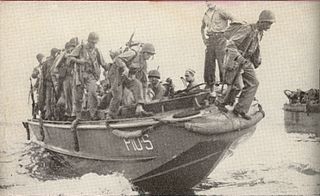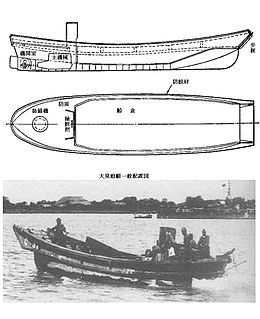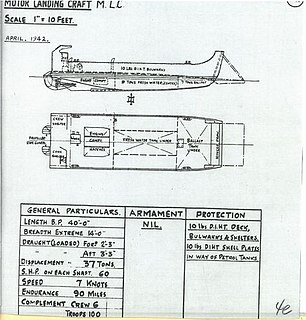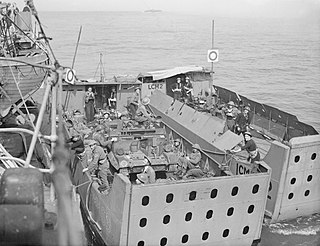
Landing craft are small and medium seagoing watercraft, such as boats and barges, used to convey a landing force from the sea to the shore during an amphibious assault. The term excludes landing ships, which are larger. Production of landing craft peaked during World War II, with a significant number of different designs produced in large quantities by the United Kingdom and United States.

A dock landing ship is an amphibious warfare ship with a well dock to transport and launch landing craft and amphibious vehicles. Some ships with well decks, such as the Soviet Ivan Rogov class, also have bow doors to enable them to deliver vehicles directly onto a beach. Modern dock landing ships also operate helicopters.

Amphibious warfare is a type of offensive military operation that today uses naval ships to project ground and air power onto a hostile or potentially hostile shore at a designated landing beach. Through history the operations were conducted using ship's boats as the primary method of delivering troops to shore. Since the Gallipoli Campaign, specialised watercraft were increasingly designed for landing troops, material and vehicles, including by landing craft and for insertion of commandos, by fast patrol boats, zodiacs and from mini-submersibles.

The Amphibious Vehicle, Tracked (LVT) is an amphibious warfare vehicle and amphibious landing craft, introduced by the United States Navy and United States Marine Corps. The United States Army, Canadian Army and British Army used several LVT models during World War II, and referred to those vehicles as "Landing Vehicle, Tracked."

The landing craft, vehicle, personnel (LCVP) or Higgins boat was a landing craft used extensively in amphibious landings in World War II. Typically constructed from plywood, this shallow-draft, barge-like boat could ferry a roughly platoon-sized complement of 36 men to shore at 9 knots (17 km/h). Men generally entered the boat by climbing down a cargo net hung from the side of their troop transport; they exited by charging down the boat's lowered bow ramp.

A Landing Craft Utility (LCU) is a type of boat used by amphibious forces to transport equipment and troops to the shore. They are capable of transporting tracked or wheeled vehicles and troops from amphibious assault ships to beachheads or piers.

The landing craft mechanized (LCM) is a landing craft designed for carrying vehicles. They came to prominence during the Second World War when they were used to land troops or tanks during Allied amphibious assaults.

A Landing ship, infantry (LSI) or infantry landing ship was one of a number of types of British Commonwealth vessels used to transport landing craft and troops engaged in amphibious warfare during the Second World War. LSIs were operated by the Royal Navy, British Merchant Navy, Royal Canadian Navy, Royal Indian Navy, and Royal Australian Navy. They transported British Commonwealth and other Allied troops in sea assaults and invasions throughout the war.

The Landing Craft Personnel (Large) or LCP (L) was a landing craft used extensively in the Second World War. Its primary purpose was to ferry troops from transport ships to attack enemy-held shores. The craft derived from a prototype designed by the Eureka Tug-Boat Company of New Orleans, Louisiana, USA. Manufactured initially in boatyards in and around New Orleans, as requirements grew it was produced in a number of yards around the United States. Typically constructed of pine planks and plywood, and fitted with some armor plate, this shallow-draft boat with a crew of 3, could ferry an infantry platoon of 36 to shore at 8 knots (13 km/h). Men generally entered the boat by walking over a gangplank from the boat deck of their troop transport as the LCP(L) hung from its davits. When loaded, the LCP(L) was lowered into the water. Soldiers exited the boat by jumping or climbing down from the craft's bow or sides.

The Daihatsu-class or 14 m landing craft was a type of landing craft used by the Imperial Japanese Army from 1937 to 1945, in the Second Sino-Japanese War and World War II. It was designated the "Type A" landing craft by the United States.

An amphibious warfare ship is an amphibious vehicle warship employed to land and support ground forces, such as marines, on enemy territory during an amphibious assault.
The Fleet Landing Exercises, or FLEX were amphibious landing exercises conducted by the United States Navy and United States Marine Corps between 1935 and 1941. The purpose of these exercises was to formulate a workable amphibious warfare doctrine. The development of the necessary craft and other equipment, and the proper tactical deployment of them were also results. Finally, the exercises demonstrated the usefulness of a standing body of Marines, the Fleet Marine Force, specially prepared for amphibious expeditions.

The Dinassaut was a type of riverine military unit employed by the French Navy during the first Indochina War. It's an example of Riverine artillery.

The motor landing craft (MLC) was a vessel used in the 1920s and 30s. It was specifically designed to deliver a tank to shore and may be considered the predecessor of all Allied landing craft mechanised (LCM). The MLC also saw action in the first year of the Second World War. Its primary purpose was to ferry tanks, troops and stores from ships to shore. The craft derived from discussions of the Landing Craft Committee; the prototype was designed by J. Samuel White of Cowes.

The Landing Craft, Mechanised Mark 1 or LCM (1) was a landing craft used extensively in the Second World War. Its primary purpose was to ferry tanks from transport ships to attack enemy-held shores. Ferrying troops, other vehicles, and supplies were secondary tasks. The craft derived from a prototype designed by John I. Thornycroft Ltd. of Woolston, Hampshire, UK. During the war it was manufactured in the United Kingdom in boatyards and steel works. Constructed of steel and selectively clad with armour plate, this shallow-draft, barge-like boat with a crew of 6, could ferry a tank of 16 long tons to shore at 7 knots (13 km/h). Depending on the weight of the tank to be transported the craft might be lowered into the water by its davits already loaded or could have the tank placed in it after being lowered into the water.

The Landing Barge, Kitchen or LBK was a landing craft used to support amphibious landings in North Western Europe during and after the Normandy invasion in the Second World War. Its primary purpose was to provide hot meals to the crews of the many minor landing craft not fitted with galley facilities. Constructed of steel, this shallow-draft lighter had storage and serving space to feed 900 men for one week. The kitchen capacity was able to provide 1,600 hot meals and 800 cold meals a day.

The ramped cargo lighter or RCL was a landing craft used in many parts of the world during the Second World War. Designed in Canada and manufactured in Vancouver and Toronto, its primary purpose was lighterage work following assault landings. The RCL also provided water transport in coastal operations. These lighters were built in sections to simplify shipping and assembled in the theatre of operations.

A Landing Craft Vehicle Personnel or Landing Craft, Vehicle, Personnel (LCVP) is any of a variety of amphibious landing craft designed to transport troops or armoured vehicles from ship to shore during amphibious landings.

Splinter fleet or Splinter navy was a nickname given to the United States wooden boats used in World War II. The boats served in many different roles during the war. These boats were built in small boatyards on the West coast and East coast, Great Lakes and the Gulf of Mexico. They could be built quickly, in just 60 to 120 days. Most of the boats were built by boatyards that already had the tools and knowledge from building yachts, sailboats and motor boats. Many were built by craftsmen in family-owned small businesses. Under the Emergency Shipbuilding Program and War Shipping Administration contracts went out to over fifty boatyards across the country. The boats were built for the US Navy, the, United States Army Air Forces, United States Coast Guard, and US Army. Some of the wooden boats went to Allied nations on the Lend-Lease program.



















